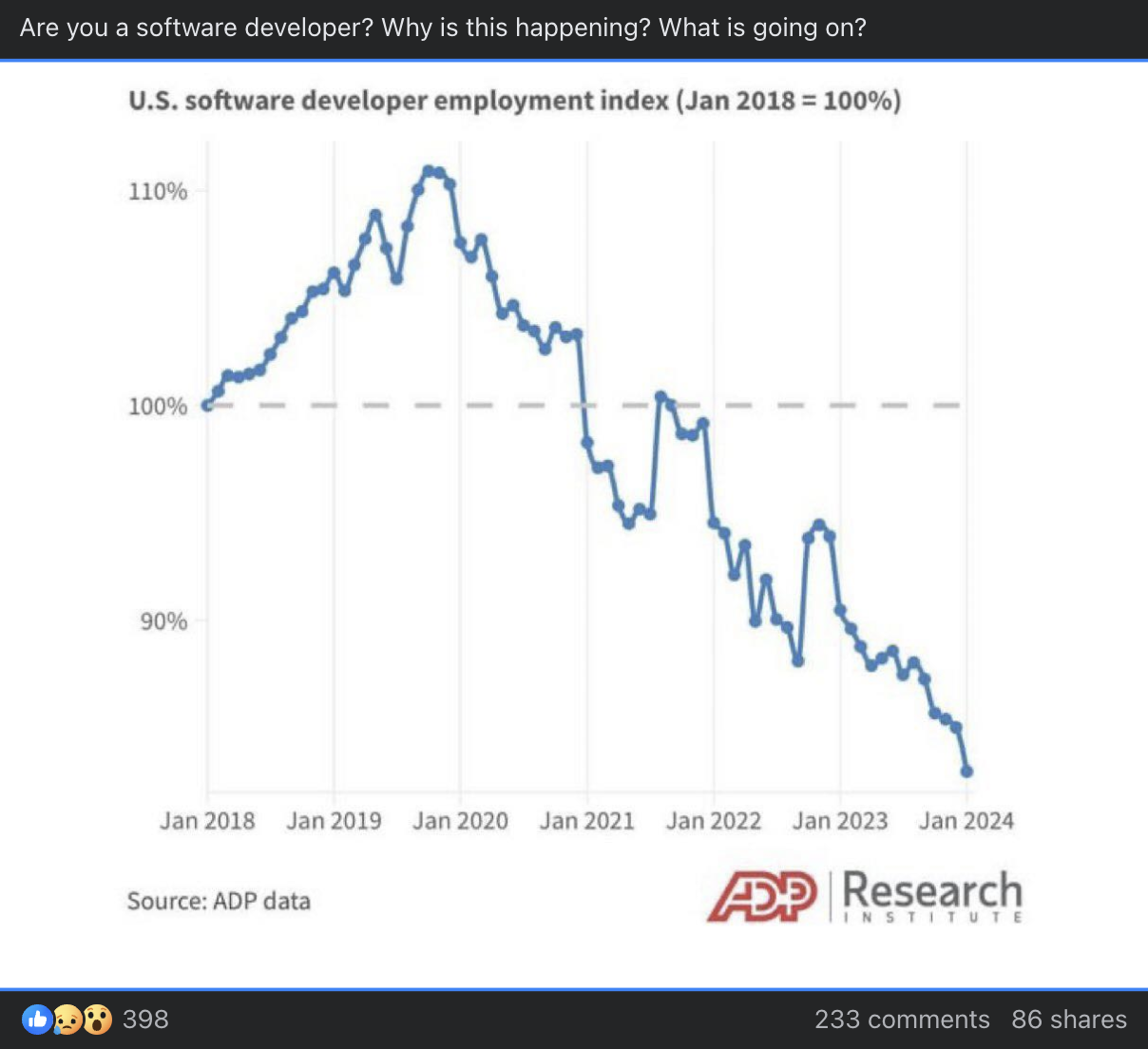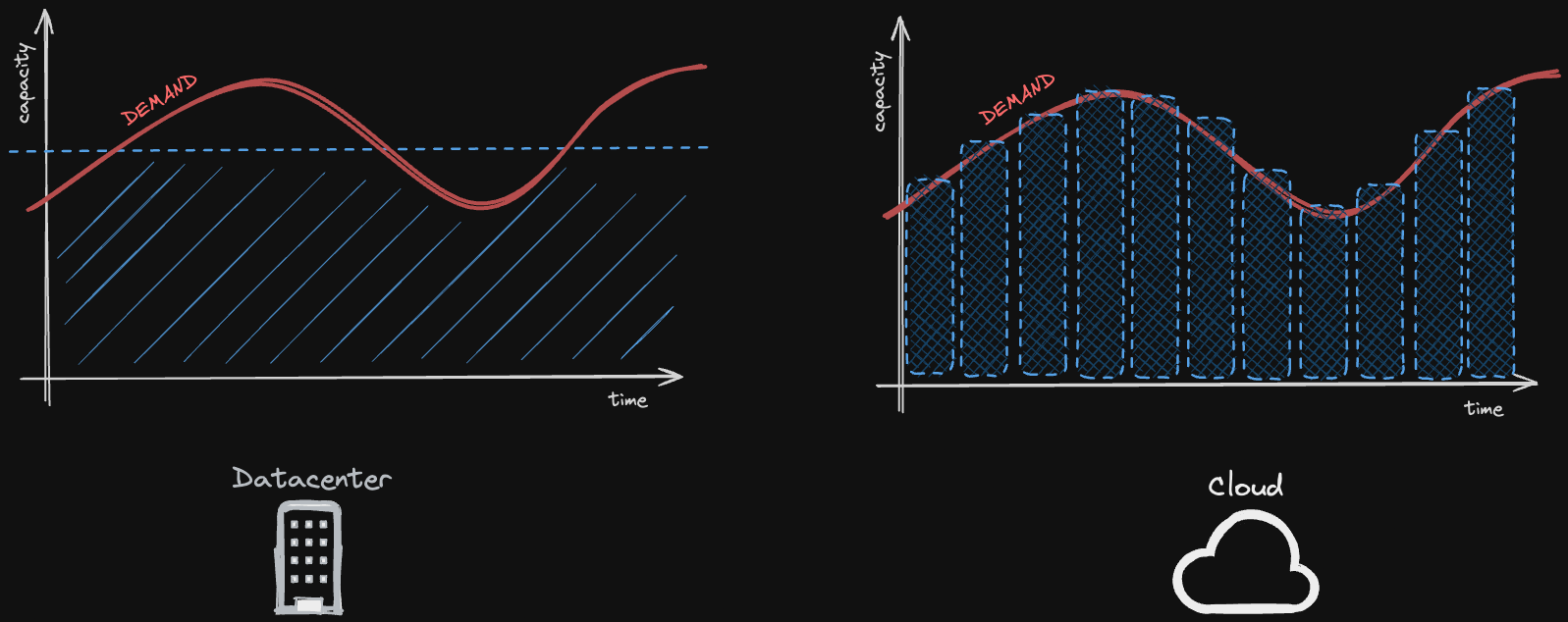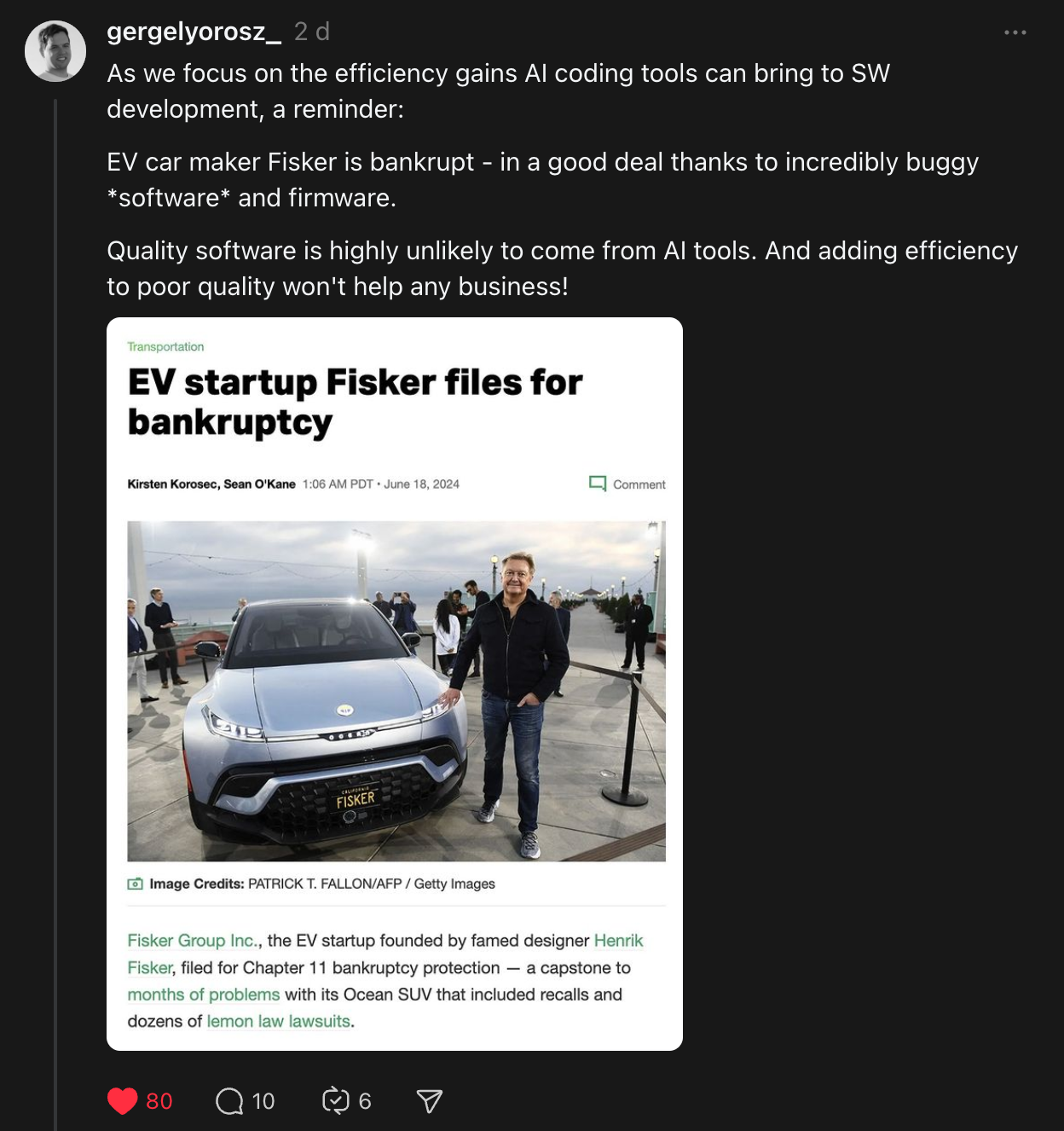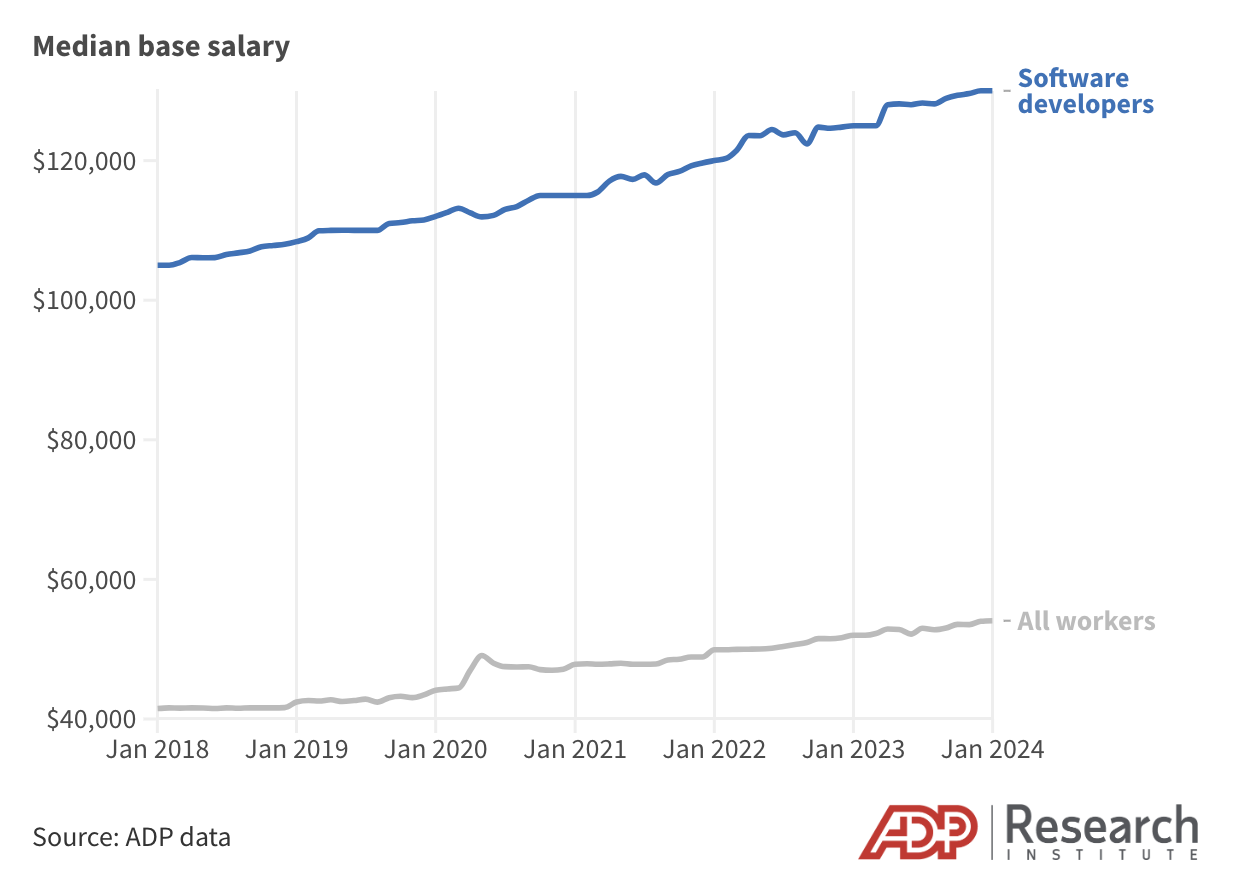I stumbled upon an article on LinkedIn recently: “The rise - and fall - of the software developer”. Two or three days later people started to share a chart from it, without any context from the original article; it shows the employment index of software developers in the US from 2018 to present:

Should we be worried? Are we going to lose our jobs? Let’s dive into the details and see what’s happening here!
Shall we?
The Rise of the Blue-collar Developers
They’re the ones who handle the Xs and Ys in formulas but rarely engage in crafting the formulas themselves.
Blue-collar workers typically engage in manual labour - think of factory workers or those in similar roles. Across various industries, these individuals play a crucial role in keeping operations running smoothly. However, their work is often considered less “highly skilled”, resulting in a lower barrier to entry. Their tasks tend to be well-defined, but oftentimes limited to repetitive activities.
Now, let’s apply this perspective to the field of software development. Do we have a comparable role? I believe we do, and I refer to these professionals as “blue-collar developers”. These individuals focus on specific, detailed tasks without necessarily concerning themselves with the broader context. They’re the ones who handle the Xs and Ys in formulas but rarely engage in crafting the formulas themselves.
Despite sharing similarities with traditional blue-collar workers — such as low entry barriers and repetitive tasks — there’s a significant difference. Blue-collar developers work within a high-demand industry, and their compensation reflects this demand.
Well, at least until now.
My Personal Experience
⏩ Hey! If you are on a tight schedule, feel free to skip to the next section - I won’t be offended! 😉
My professional journey in software development began around 2012. Prior to that, I worked at a cinema chain, wearing multiple hats as a system administrator and a site manager. Simultaneously, I pursued self-taught development, running a side hustle focused on web development and custom CRMs (back in the day, almost everyone started their career as web developers — well, PHP developers, to be precise. 😅).
Upon realizing that software development is my cup of tea, I submitted my resignation. Pretty soon I received an offer from a local company in my hometown. Our niche was industrial control and automation. Although hired as a software developer, my responsibilities extended beyond mere coding. I did everything from maintaining sensors and PLCs to writing C# code for background services. Additionally, I maintained servers in the back office of oil refineries and gas storage facilities. Those were wild times! 👷
During those years, I acquired valuable skills — essential for any professional. I learned how to function effectively as a team player, communicate with non-developers, and cultivate resilience.
However, after five years, I reached a crossroads: my current position offered no room for growth, and I wasn’t acquiring new knowledge. The fear of becoming a perpetual blue-collar developer drove me to seek change. So, I made a bold move: I left this company as well, just to join Precognox as a Java developer. Here, I’ve embraced my role as a senior Java backend developer, focusing solely on this field. No more juggling multiple tasks - I’m committed to mastering one subject matter. I was 100% sure it is the smartest idea I’ve ever had.
I couldn’t have been more wrong.
More on that later - let’s not get ahead of ourselves. Fast-forward to around 2018, a time when individuals without formal backgrounds or tangible experience could land developer jobs. Degrees? Optional. Motivation? Not a deal-breaker. The scarcity of developers led companies to hire anyone willing to write code, regardless of traditional qualifications. With the guidance of seniors acting as lead developers, there were always some “low-hanging fruits” to pick up.
In traditional industries, faced with massive scale and high demand, companies would have turned to automation. Surprisingly, this approach hadn’t yet available in the realm of software development.
Welcome to the era of blue-collar developers: everyday individuals in high demand, commanding impressive salaries, yet entering the field with surprisingly low barriers.
But wait a minute! Is it limited to the software development industry? Not at all! The same phenomenon occurred in other crafts and professions where human labour was in high demand. The rise of blue-collar developers mirrors the rise of employees in other industries. Think about the hospitality sector, or the construction industry.
The Fall of the Blue-collar Developers
Between 2018 and 2020, I experienced remarkable times. My salary didn’t just increase; it skyrocketed. I wouldn’t say I didn’t deserved it! I worked diligently, put in overtime, and even made myself available on weekends, all while striving to minimize response times. Yet, I couldn’t ignore the reality: many others around me followed a similar path, albeit with less financial success.
What Goes Up, Must Come Down
I had a mantra: “Listen, this won’t last forever. You need to prepare for rainy days”. For companies that relied on software — and as we all know, now “every company is a software company” — these were indeed the rainy days. Their fate rested in the hands of introverted, socially awkward, and occasionally unreliable geeks with ridiculously high numbers on their pay checks.

I remember the first lockdown in Hungary. For a lot of people, it was quite a wild experience. For me, it was just another day at the office.
The pandemic hit, and the world changed forever. I remember the first lockdown in Hungary. For a lot of people, it was quite a wild experience. For me, it was just another day at the office. Err, I mean, at the home office - I was already working from home, so the transition was seamless. But for many others, it was a nightmare.
For many people, it dealt a fatal blow to their careers. Imagine being in the shoes of a waitperson, a cook, or a barista — for them, job security was a thing of the past. Although I wasn’t directly affected, the events shook me. I realized that the same could happen to me. Consequently, I began ordering takeout more often to support local businesses. My donations increased significantly, all while pondering whether others might order custom built software to save me from the same fate. 🙃
Companies swiftly adopted to the new situation: Their digital transformation gained momentum, driving automation and modernization across their operations. Here is an example from Hungary: before the pandemic, e-tickets for public transportation were mere wishful thinking (well, except train tickets). I remember fumbling for cash to buy those paper-based tickets directly from the bus driver. Beyond contactless payments, the pandemic accelerated companies’ online presence, the e-commerce sector, and the digitalization of various public services as well.

Image source: YaleMedicine: Our Pandemic Year - A COVID-19 Timeline
The situation for fresh graduates was dire. Needless to say, it was a challenging time to (literally) enter the job market. Many businesses were struggling to stay afloat, so despite the ongoing digital transformation, they weren’t actively hiring. Some companies even went bankrupt or had to postpone their digital projects.
For developers already employed in companies working in less affected industries, the situation was different. Personally, I was so busy that I didn’t even have time to dwell on the pandemic.
Light at the End of the Tunnel?
After governments lifted curfews and lockdowns, the world began recovering. However, a new crisis emerged: Russia invaded Ukraine. This conflict had a global impact, causing energy prices to soar and inflation to worsen. Following the first shock, many European countries turned their attention to achieving energy independence (reducing reliance on cheap Russian gas). Without delving into details - since I’m not running a geopolitical or economic blog -, suffice it to say that situations grew even more complex.
Meanwhile - thanks to the recession -, central banks raised interest rates, marking the end of The Era of Easy Money — a time when institutional and venture capital poured into tech companies without restraint. Since you’re not reading a financial blog, let me put it simply: as interest rates rise, it’s wiser to keep your cash in a bank account rather than risking it in a volatile tech business.
But then, in late November 2022, OpenAI introduced ChatGPT, a conversational AI model capable of producing human-like responses.
This was the beginning of the AI Boom.
Investors got into the mood, and money started to flow into AI-related companies. Suddenly, every company was investing in AI, driven by the urgency to create AI-powered solutions. Everything had begun to be “Powered by AI”.
Developers Meet Efficiency
The AI Boom served as the long-awaited remedy for the industry. It amplified the efficiency of skilled developers while leaving inefficient ones vulnerable to layoffs.
Generative AI and Large Language Models (LLMs) have revolutionized the way people work behind computer screens. Numerous case studies and reports have emerged, predicting job losses due to GenAI. One thing was very common in these articles:
Developers will be one of the first to go.
However, it’s not as plain as it looks. Like industrial robots never truly replaced blue collar workers, AI will never replace developers completely… at least not in the near future. The AI Boom served as the long-awaited remedy for the industry. It amplified the efficiency of skilled developers while leaving inefficient ones vulnerable to layoffs.
But who took their place? ChatGPT? GitHub Copilot? Not quite. The true successors were those who had always been there: some might call them “the 10x developers” - though I am not particularly like that term. Anyways, consider the professionals who are eager to learn, adapt, and grow. Staying informed and up to date is crucial across all industries, but it’s especially vital in ours. So, it’s not that AI replaced developers; rather, it’s the developers who recognized the significance of AI tools and trends and have already integrated them into their toolset.
History repeats itself. Consider the advent of the internet, search engines, and platforms like StackOverflow. When I was a kid, I typed out entire code snippets from books or magazines to understand how they worked. Now, if I have an issue, with a simple search, answers are readily available. Another example: back in the days, companies built their own data centers. Every company had a dedicated IT team to maintain those servers. However, the cloud revolutionized this landscape, streamlining scalability and efficiency.

If you have a look at my illustration, you can see the real advantage of the public cloud: the elasticity! No need to pay for resources which aren’t utilized - and suddenly it was possible to avoid underprovisioning when demand was high. Scaling out vs. scaling up, the cloud is the clear winner. As these technologies were miraculous when they first appeared, very soon they became the norm. If you ask me, the same will happen with AI.
We Need to Recalibrate

“The value of 90% of my skills just dropped to $0. The leverage for the remaining 10% went up 1000x. I need to recalibrate.”
We finally arrived at the main point of this article. While Kent Beck may not fit into the role a blue-collar developer (hahh!), his insights resonate with the topic. What exactly does a blue-collar developer do? They dutifully follow instructions, execute assigned tasks, and excel at solving problems with well-established solutions. However, they are not very good at solving new problems with a few solutions, or problems with no known solutions.
What does an AI Assistant do…? I think you get the point: now blue-collar developers got a competitor. For 10 or 20 bucks a month, everyone can have a blue-collar developer at their disposal. A Copilot, an Assistant, an Agent, call it whatever you want.
AI excels at tasks that often burden developers, such as scaffolding CRUD operations in REST endpoints, writing boilerplate code (like getters and setters), and even applying design patterns. AI can also write documentation based on code or even generate unit tests. The value of these tasks has suddenly dropped to zero.
Resonating with Kent Beck’s words, the leverage for the remaining 10% of our skills has increased significantly. The only thing we need to understand is that nobody will pay us for crafting quality software at such a slow pace before.
I need to emphasize that quality is still important:

Source: Gergely Orosz’s Threads
While AI may not affect directly the quality of the software we produce, the responsibility clearly remains with us. However, in this era of the AI Boom, recalibration is essential. We must be willing to learn extensively. Rather than focusing solely on one technology, programming language, or framework, we’ll need to adapt. This means switching focus not only between different projects but also across various tech stacks.
Try to be an M-shaped Professional
What does it mean? Let me explain.

In a previous section, I expressed that I wanted to be really good at Java backend development, aiming to become an “I-shaped professional”. This choice felt natural, especially after years of being a ‘jack of all trades’. However, I quickly realized that this approach wasn’t very wise. In the current era of the AI boom, it’s an even worse idea.
In the context I’ve described with my illustration, Java backend development represents my ‘I’. I have a deep understanding of this field, but my knowledge in other areas is limited. What’s wrong with that? In the past, the primary concern was being “benched”. However, today, the challenge lies in vulnerability to AI. If you’re fortunate enough to find your niche and have confidence in your skills, you can remain secure — until the demand for your specialized knowledge persists.
As a rule of thumb, GenAI excels in tasks and technologies that are well-established, popular, and widely used. Now, change perspective and say aloud Ken Beck’s words again:
“The value of 90% of my skills just dropped to $0. The leverage for the remaining 10% went up 1000x.”
Indeed. Writing a REST endpoint in Java or creating a login page in React or Angular is no longer a significant challenge. However, tackling problems in uncharted territories — whether related to technology or business domains — is still a formidable task.
That’s the critical 10% we must focus on.
Let’s talk about being a “T-shaped professional”. This one is a better choice than the previous one. The horizontal bar represents a broad range of skills, while the vertical bar signifies a deeper understanding of a specific field. You gave up being the best Java developer in the world, so now you can focus on having a good grasp of other crafts and technologies as well. You embarked on a journey of being a generalist. That’s good, because employers value generalists, and in the other hand, to efficiently command your AI Copilot, you need to understand the basics of the tasks it performs. The more topics you are familiar with, the more efficient you will be in utilizing AI tools. It’s a win-win situation.
My advice, though, is to aim for the “M-shaped professional”. This is the best choice in the era of the AI Boom. You can be a Java backend developer in one project, a data scientist in another, and a DevOps engineer in a third. You can be a generalist, but you can also be a specialist. You can be a “jack of all trades, master of some”.
AI Agents, such as GitHub Copilot, can help you augment your knowledge, but it is still true that zero multiplied by any number is still a zero.
What I oftentimes did in new projects is to learn all the technology stack I’ve never used before at a foundational level, even before the project started. The only thing is needed a well-established learning platform, strong commitment and a few calm evenings, or weekends. It’s time to turn down your impostor syndrome a notch: you don’t need to be an expert, since AI Agents, such as GitHub Copilot, can help you augment your knowledge; but it is still true that zero multiplied by any number is still a zero.
Finally, let me put here a second graph from the article I mentioned at the beginning:

The clickbait articles and social media posts usually forget to mention this part. While it’s true that the devil is in the details: higher efficiency can lead to layoffs. However, it also results in better compensation for the skilled developers. Interestingly, the AI Boom hasn’t significantly affected the median salary of developers, as shown by the data above.
Wrapping Up
The era of the blue-collar developer is coming to an end, and surprisingly, it’s not all bad news. As software continues to play an increasingly vital role in our lives, the industry has faced challenges in meeting the growing demand. While low-code and no-code platforms didn’t quite provide the solution, Generative AI has stepped onto the scene. This technology enables more efficient, cost-effective, and faster software development, benefiting a wide range of users.
However, not everyone is thriving in this new landscape. Coders with limited skills and a lack of adaptability find themselves vulnerable to layoffs. The question arises: Can we truly call it a layoff when, ideally, they should never have been hired in the first place?

Image source: Henrik Kniberg: Are developers needed in the age of AI?
No one can predict how things will unfold in the future. As software development becomes a profession like any other, we need to adapt to the changes. Copilots, Assistants, Agents — whatever you choose to call them — are tools at your disposal. There’s no need to be shy: use them. Avoid being that guy with the shovel if everyone else is using an excavator. Instead, cultivate new skills, become a generalist, take ownership of your customers’ problems, and be the one who crafts the formulas.
AI will handle the Xs and Ys.
